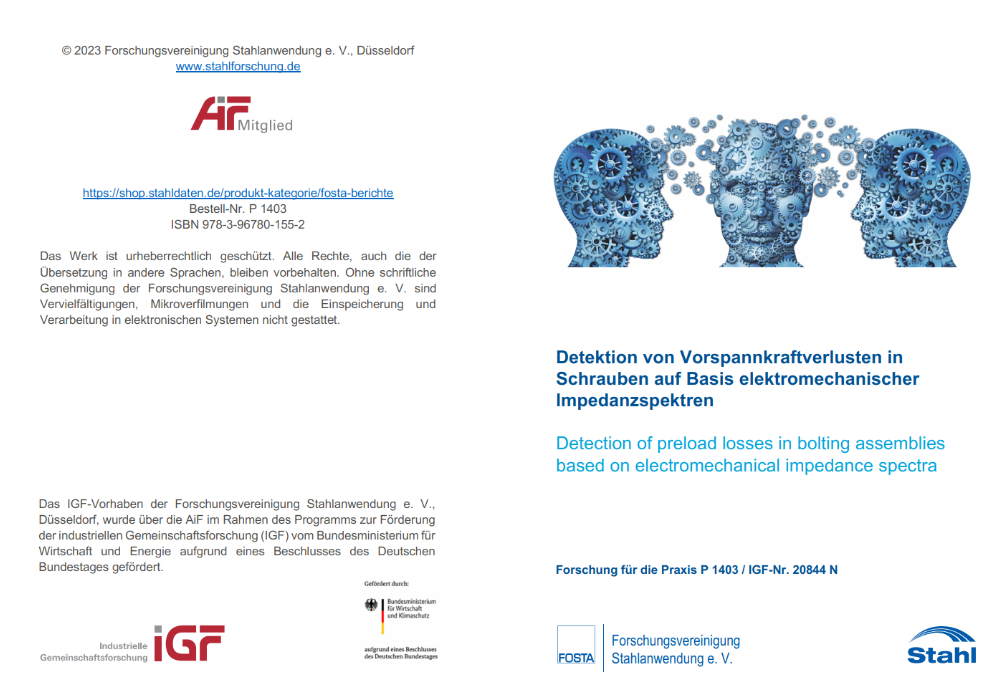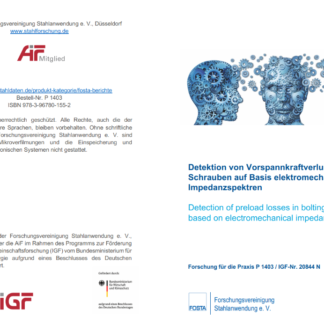Description
P 1403 – Detection of preload losses in bolting assemblies based on electromechanical impedance spectra
Bolts in HV connections are pretensioned, whereby the operational safety of these bolted connections is significantly influenced by the level of the pretensioning force. However, the generation and preservation of the required pre-tensioning force before and during operational loading is not always sufficiently successful. A loss of pre-tensioning force due to automatic loosening during the operational loading of bolted joints can be caused by two different reasons, namely by loosening because of settling or creep or by automatic loosening of the bolt and/or nut. Pretensioned bolts relax due to settlement of the surfaces of the clamping package (levelling of surface roughness, creep of coating).
Creep occurs when the interfacial pressure of the pressure-loaded surfaces is exceeded. These effects are time-dependent and lead to a reduction of the preload force. However, especially in the case of bolted joints subject to vibrations, failure is also often due to loosening and/or self-loosening during operation. This is equivalent to the complete or partial loss of the pretensioning force, which in many cases results in a fatigue failure of the bolt.
In this research project, a method was developed that enables cost-effective, continuous monitoring of the bolt force, e.g. within the framework of structural health monitoring (SHM). The monitoring of the bolt force is carried out with the help of electromechanical impedance spectra.
To introduce the topic, chapter 2 gives a short overview of the state of the art and discusses the current methods for measuring pretensioning forces in bolted joints (chapter 2.1) as well as options and objectives of the pretensioning of bolts based on the currently valid standards and guidelines (chapter 2.2).
Based on this, the fundamentals of measurements based on electromechanical impedance spectra are presented in chapter 2.3. It is explained what electromechanical impedance spectra are, how they are generated and what is needed for the measurement of electromechanical impedance spectra. This part of the report is aimed particularly at readers who have had little or no contact with electromechanical impedance spectra. Furthermore, a brief overview of the specimens used in the project is given by means of an exemplary presentation of an M16x50 specimen equipped with measurement technology.
Subsequently, the factors that are important for the measurement of electromechanical impedance spectra are explained with reference to the present application case using exemplary FE calculations; the influences of preload force, temperature, sensor damage and adhesive layer on the electromechanical impedance spectra are explained for this purpose.
Based on this, the (physical) background to the measurement of electromechanical impedance spectra is concretised and deepened in chapter 0. The correlations between the development of electromechanical impedance spectra and the influences of preload, temperature and sensor damage are explained in detail, which were already presented in the previous chapter 2.3. By deriving causalities, it can be shown in which parameter ranges the influences of preload, temperature, sensor damage and adhesive layer on the impedance spectra are valid.
Chapter 2.5 explains the statistical evaluation of the data according to the Military Handbook 1823. The main focus is set on the procedure and the aim of the statistical evaluation and the choice of the method for the evaluation.
Chapter 3 first explains the principles of the experimental investigations (chapter 3.1) and, building on this, the results of the preliminary investigations (chapter 3.2). On the basis of the preliminary tests, the spectra used to evaluate the preload force, temperature and sensor damage were determined.
Subsequently, the series measurements are presented and evaluated (chapter 3.3). Thus, it is first shown how a loss of preload force and its magnitude can be reliably detected on the basis of the evaluated measurements at constant temperature. The compensation of the temperature influence is carried out in chapter 3.4. Finally, it is shown on the basis of a statistical evaluation in which order of magnitude the preload losses are, which can be detected in at least 90 % of the cases with a confidence of 95 %. In chapter 3.5 the tests for damage detection in the measurement chain are presented and a procedure is developed which enables the detection of typical damage. The additional tests carried out on M72x380 HV bolts are briefly presented in chapter 3.6. Subsequently, the results of the ultrasonic measurements are discussed in chapter 3.7.
All research reports in german language only!
Published in:
February 2022
Authors:
Univ.-Prof. Dr.-Ing. D. Pak, Dr.-Ing. D. Sahm, Univ.-Prof. Dr.-Ing. C.-P. Fritzen, A.-L. Dreisbach, M.Sc


